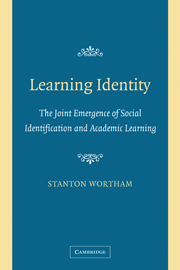Book contents
- Frontmatter
- Contents
- Acknowledgements
- 1 Self/Knowledge
- 2 Social Identification and Local Metapragmatic Models
- 3 Academic Learning and Local Cognitive Models
- 4 Tyisha Becoming an Outcast
- 5 Maurice in the Middle
- 6 Denaturalizing Identity, Learning and Schooling
- Appendix A Abbreviations of Names
- Appendix B Transcription Conventions
- References
- Index
6 - Denaturalizing Identity, Learning and Schooling
Published online by Cambridge University Press: 05 June 2012
- Frontmatter
- Contents
- Acknowledgements
- 1 Self/Knowledge
- 2 Social Identification and Local Metapragmatic Models
- 3 Academic Learning and Local Cognitive Models
- 4 Tyisha Becoming an Outcast
- 5 Maurice in the Middle
- 6 Denaturalizing Identity, Learning and Schooling
- Appendix A Abbreviations of Names
- Appendix B Transcription Conventions
- References
- Index
Summary
In The Paideia Proposal, Adler argues that American schools are failing to fulfill their central mission of preparing students to participate in democracy. Now that the United States has progressed to universal suffrage, he argues, our educational system must prepare all students for their rights and responsibilities as citizens. We must overcome “the cultural inequality of homes and environments” (Adler, 1982: p. 39) and provide truly equal educational opportunity to all, such that we become “an educationally classless society.” To accomplish this, Adler prescribes the Paideia curriculum in which all students have the opportunity to read classic texts and relate these texts to their own lives through seminar discussion. A Paideia education will give disadvantaged students equal access to the powerful ideas found in classic texts, and it will show these students how such ideas can be connected to their own lives. This will not only enrich their lives, but it will also allow them to participate fully in democracy and accomplish social mobility.
Tyisha and Maurice's trajectories of identification can be read as ironic commentaries on this educational vision. Mrs. Bailey, Mr. Smith and their students used ideas from classic texts, together with other resources, to identify Tyisha and Maurice as disempowered outcasts from the classroom community. Teachers and students used classic models of the relation between an individual and society, for instance, like Aristotle's account of anti-social “beasts,” as resources when they excluded Tyisha and identifed her as disruptive.
- Type
- Chapter
- Information
- Learning IdentityThe Joint Emergence of Social Identification and Academic Learning, pp. 273 - 290Publisher: Cambridge University PressPrint publication year: 2005



